, Group Planning Director at TMW
Before a brand commits to any social media campaign, activity or platform it’s clearly essential to understand how their target audience behaves in these environments. For example, which environments does your target audience frequent? How active are they in this space? Are they the types of people who proactively share and contribute to the conversation or do they prefer to observe by the sidelines? Are they likely to invest time and energy in UGC or would such an invitation fall on deaf ears? What are the motivations and key drivers that lie behind their social media behaviour?
Unless one can answer these types of questions, there’s a fair chance your social media efforts could all be in vein. The good news, however, is that there are a number of sources, tools and frameworks available which can help us build a fairly informed picture of our target audience’s social media profile. And the best bit, most of them are completely free! Outlined below are the ones I’m most familiar with or have found to be most useful over the years. I’ve also restricted the list to those tools which can be applied across European markets and not just the US.
1. The Global Web Index
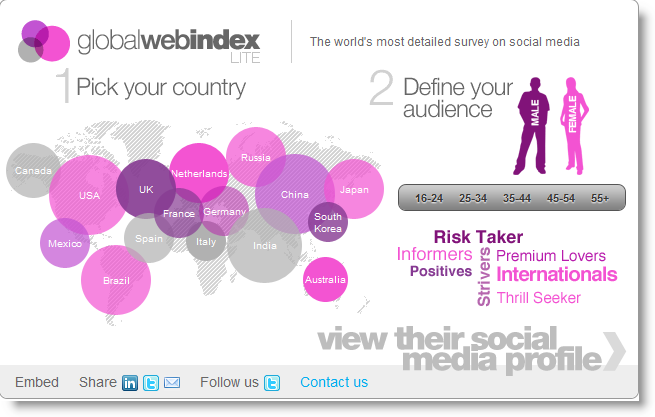
The Global Web Index (Lite) is a nifty little free tool recently published by Trendstream to help you view the social media profiles of different online audiences across Europe. It’s based on a quantitatitive survey and manages to overlay social media behaviour and motivations by country, age and attitudinal profiles. The full version will have a lot more meat on the bones but for a quick snapshot this Lite version can be quite an insightful tool, particularly when comparing against different markets.
2. Universal McCanns Social Media Tracker
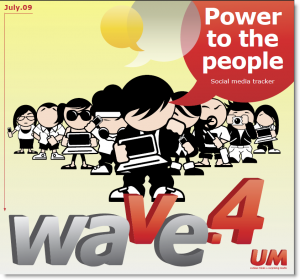
This in my view is the holy grail when it comes to tracking trends in social media from a global perspective. It’s been going a few years now and is an essential point of reference for anyone trying to identify behavioural trends in social media. There’s a free Silverlight-based tool here which is quite fancy but for usable insights and stats you really need to read the Wave 4 report . Pure gold dust!
3. Forresters Social Technographics Tool
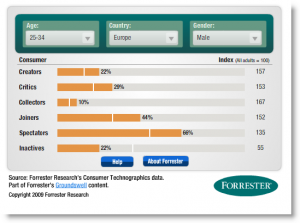
Forrester’s social technographics tool has been around for a while but is still a great way to map your target audience’s propensity to participate in social media. With this tool you can get a decent idea whether your audience over indexes for certain types of behaviour. So for example, if they over index as ‘creators’ there’s a fair chance they’d be receptive to getting involved in a crowdsourcing or UGC project. Conversely, if they’re predominently spectators and inactives, don’t even go there!
Unfortunately some European markets are not covered for some age profiles which I assume is because they don’t hold enough survey data but for broad, topline assessment of socialgraphics it’s a great place to start.
4. Altimeter’s Engagement Pyramid
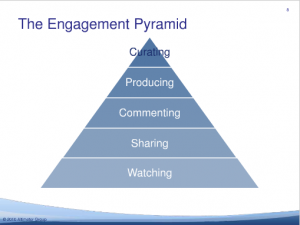
This isn’t a data analytical tool as far as I believe but rather a strategic framework to help map the different ways in which consumers engage in social media. Even though there’s no data to substantiate this, it’s good common sense and highlights the importance of socialgraphics to help inform social media strategies rather than simply relying on traditional demographic and psychographic profiles. If you want to know more about this interesting approach I’ve reviewed it more fully on my blog.
5. TMW’s Motivational Drivers to Social Media Participation
Understanding ‘how’ your target audience participates in social media is key but only one piece of the jigsaw. It’s also important to ask yourself ‘why’. At TMW, we conducted some research in conjunction with research agency ICM to help identify the motivations behind social media participation. We concluded there are 6 key motivational drivers for participating in this space.
* Discovery: for self-development or to learn from others
* Altruism: to help others make the right decision or become involved in the brand’s product decision
* Social: to connect to the like minded, reinforce tribal identity or gain a sense of belonging
* Fame: for personal notoriety or to challenge their ability against others
* Escapism: for entertainment and an escape from the daily routine
* Expression: as an outlet for their imagination or expression of personal identity
The interesting thing is that these motivations change according to different demographics. You can read some of the insightful results from this study on my blog here where we explore the differences in motivations between gender and age.
6. TGI Net Europa
Launched in September 2008, with new data released twice a year, TGI Net Europa combines the full TGI Europa database with extensive detailed information on internet behaviour and attitudes. To be fair it’s probably more useful to draw broader conclusions on internet behaviour for a given target audience than building robust socialgraphic data. It’s not a free tool either so if you want access this type of data you may have to ask your media agency nicely!
7. Social Media Statistics Compendium by econsultancy
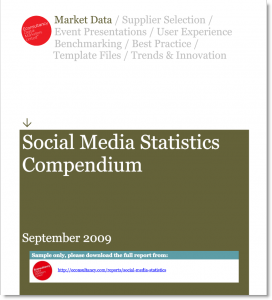 The Social Media Statistics Compendium is one of the reports bundled with the eConsulancy’s Internet Statistics Compendium. It costs £250 on its own but is jam packed with useful stats on social media from a variety of third party sources.
The Social Media Statistics Compendium is one of the reports bundled with the eConsulancy’s Internet Statistics Compendium. It costs £250 on its own but is jam packed with useful stats on social media from a variety of third party sources.
8. CheckFacebook.com

If you want to understand the profile of Facebook users within your country and compare this to your target audience profile, it’s worth visiting . It’s free too.
9. Nielson’s Global Faces & Networked Places Report – March 2009
Nielson’s Global Faces and Network Places report looks at the social media market as a whole but does have a useful section on how the audience is changing and starting to mature.
10 IAB Online Audience Research
Last but not least, there are a number of helpful online research papers available to IAB members including some for specific audiences such as women, Mums and luxury consumers)
Summary
So there you have it – a mix of tools and approaches to help you build up a social media profile of your target audience. It’s not an exhaustive list by any stretch of the imagination so if you know any more I may have missed feel free to add them below.
By , Director of Regulatory Affairs, IAB
Earlier this week the Advertising Standards Authority (ASA) announced its intention to extend its self-regulatory digital media remit from 1 March 2011. This will cover business’ own marketing communications on their own websites as well as in other non paid-for space under an advertiser’s control, such as social networking sites. All paid-for digital advertising, such as PPC search, display and (commercial) classified, is already covered by robust rules to protect consumers and promote trust within the sector.
What does this mean?

It means that the self-regulatory system for UK advertising is keeping pace with evolving digital marketing. The IAB has published a set of FAQs which provide further details on the extended remit. So what is really changing? The extended rules will toughen up on those that use these platforms to market age-restricted products, such as alcohol, as well as apply the existing food marketing rules. These are ‘thorny’ issues and so we should welcome this. The politicians certainly will. Chris Reed from PR and social media agency Brew Digital summed it all up very nicely: he concludes that “for most of us working in this space it should mean no change whatsoever.” He’s right. These new rules should not replace true self-regulation. Businesses should treat all marketing communications / ‘conversations’ with consumers as within remit to uphold the integrity of digital marketing. Read more…
For the last twenty-four months, or so, storytelling has become more important to Account Planners and Brand Strategists alike. Stories are memorable; stories get shared; stories deliver meaning and answer the innate why and how questions: How did you come to be? Why are you talking to me? Why should I buy your product?
Our analysis team has been working to understand product anecdotes for some of our clients recently. This has involved reading some of the everyday product stories that are embedded within social media.
Their findings have been fascinating and they have stimulated conversations that question the direction of the brand, its segmentation preferences and marketing activities. The key takeaway for us: Before you start to tell your story, read the stories that have already been written about your brand and understand their contexts and implications.
Understanding what’s already out there will better place us, brand people, to define our own stories, make them culturally relevant and ensure they effectively answer the aforementioned, innate questions.
Dhiren Shingdia – Market Sentinel
By Iain MacMillan, RMM
Over on the RMM blog, we explained what Facebook Places was, how it worked and who might use it.
While that post looked at how Facebook’s users might use Places, we’ve also been thinking about what advantages the new feature offers brands – particularly over Foursquare.
Currently, Foursquare users get the benefit of social gaming through collecting badges, discounts from brands like Starbucks and a new kind of interaction with friends. Facebook currently offers only the last of these three options. It hasn’t stolen the mechanism of rewarding users through badges, nor has it benefited from a lucrative partnership like Starbucks offering Foursquare power users free coffee. But Facebook Places may have the sheer might needed to expose a brand to large, hitherto untapped networks of friends, colleagues and family.
Facebook has a ready-made user base
, Foursquare has 2.5 million users. Very impressive for a start-up but in hard numbers barely comparable to . With such a massive user base, it will be Facebook Places and not a single-serving start-up which pushes geo-location into the mainstream over the next few years. There is little incentive to add users to your Foursquare network when they can access your status updates publicly via Twitter. But Facebook is a closed network; Places provides a new way in for brands.
This means any brand reliant on a bricks-and-mortar location should be quick to claim their postcode on Facebook Places – the quicker the uptake, the more noticeable to users. More so than Foursquare, if a user checks into your Facebook Place it will display to a potentially massive network of prospective customers. Brands who have marked themselves on Places may find themselves as a meeting or talking point among large networks of friends who have tagged themselves and each other on check-in.
Places will affect your fan page
There’s an option for any brand with a Facebook fan page to ‘merge’ this with the new Places functionality. Doing so will update your page design to reflect a map of your location and – importantly – status updates of everyone who has checked in there, whether a fan of your page or not.
Unfortunately there’s a flaw –this doesn’t really work for any brand with multiple locations to map. The natural step from here would be to consider creating individual pages for individual stores; creating smaller but potentially more loyal communities around single locations and also driving footfall.
Facebook is brand-friendly
Out of all the mainstream social media platforms, Facebook is the most nakedly interested in making money out of its users – for better or worse. Its swift release of the Places advertiser guidelines, despite technical teething problems with the new feature, suggests Facebook is keen to broadcast Places as an opportunity for brands as much as users. It is very much in Facebook’s interest to ensure brands can exploit Places for commercial advantage more quickly, easily and cost-effectively than the rival Foursquare over the upcoming months – which is why, as a brand, it would be smart to keep an eye on it.
Yesterday saw our final session on the IAB’s rising voice in social media course. The installment was rounded up with presentations from Nick Stringer, director of regulatory affairs at the IAB and , senior marketing manager at Skive. Nick took the delegates through why it’s important to be ‘safe’ in social media, covering the all important ASA remit extension that comes into place in Spring 2011. Tom Ollerton, senior marketing manager at Skive spoke about his opinions on whats next for social media with some great examples.
See below to view both presentations in full…
By , senior PR and marketing manager, IAB
Whilst it’s important to blog about new technologies, platforms and Twitter’s ‘who to follow’ function, there are some issues within social media that are oldies but goodies, and remain deserving of our attention.
An associate kindly sent me this press release yesterday, and I must say I was jolly interested. Not because I want to buy the Club IAB page on Facebook tens of thousands of new recruits, but because I pondered for at least 3 minutes as to who else received it, and who out of those people was tempted to part with their cash. It might be a joke (particularly having read the blog) and if it is, a very funny joke it is too. The press release is below, but without the company details:
Facebook Popularity On Sale To The Highest Bidder - The ’social’ may soon be taken out of social media site Facebook as popularity on the site can now be sold to the highest bidder.
A certain ‘Social media marketing company’ has begun selling fans and friends on Facebook to businesses and organizations wanting to increase their exposure online and they’ve now announced they are selling up to 20 million fans at a time, meaning just about anyone with a “fat wallet” can be more popular than Lady Gaga, at least on Facebook. Read more…
By , Digital & Social Media Director, markettiers4dc Group
Earlier this week I checked into Sa Fàbrica de Gelats on Foursquare to let my friends know that I’ve just bought one of their speciality Orange ice creams whilst in Soller in Mallorca on holiday.
Now, why they would care to know that is another debate! The reason I did it, however, is because as part of my job, I’m still trying to understand the benefit this latest alleged Social Media star can have to my clients, and at the moment, I’m still struggling to find the answer. Read more…
, Head of Social Media at Microsoft Advertising, talks to the IAB about social media from an advertising and product perspective. Kicking off with a simple explanation of what social media is and why it’s so vital for CMOS, she uses her own case study from the Windows 7 launch as a great example of how you can use dialogue with consumers to inform business research and product development. Watch the interview in full below to also find out what future trends she feels will be hitting the social media industry next.
, Head of Digital Strategy at Imagination talks to the IAB about how social media has heightened the brand experience. Discussing the relationship between the consumer and the brand, she outlines the ways in which consumer expectations have been heightened thanks to digital, and the increased feedback that marketers are getting in social spaces. Using case study examples from Debenhams and London Museums, and argues that a successful case study is essential to persuade a brand to take that first step into ‘doing’ social media.
Watch the below video to see the full interview
By Daan Jansonius, Account Manager, SocialMedia8
Warner Bros’ recent influencer program faux pas has been widely publicised and critisised by many social media commentators. Recipient of the irrelevant and badly targeted outreach e-mail Adam Singer shared the incident with his readers on his Future Buzz blog, after which TechDirt and Repution Online among others chipped in their 2 cents too.
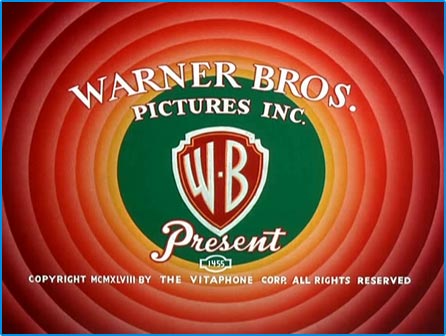
Warner Bros made matters worse with an ill thought out response, defending their efforts in a comment saying it was ‘fully WOMMA compliant’. Whilst this may be true, it’s no defense for a campaign to lack basic common sense. However, we prefer to help brands move ahead with positivity and helpfulness rather than scorn and damnation.
So let’s look at where Warner Bros went wrong and how they could avoid a similar PR nightmare next time.
1) The the outreach email
There are two issues here. Firstly, there is a lack of personalisation which is an immediate red flag for most bloggers. Warner Bros claims to have come across Singer’s blog recently which is why he was invited. This claim lacks authenticity when you fail to include the person’s name in the salutation.
Secondly, and more importantly, if they had actually read the blog they would have noticed that Singer’s posts mostly revolve around online marketing. Whilst there may have been posts about online marketing in relation to the entertainment industry, he is not known for sharing his love for the latest blockbusters.
It’s great that Warner Bros is looking to involve their biggest fans through a loyalty program – but you have to make sure you target the right people. These errors point in the direction of a shotgun approach where they fired as much hail at bloggers with a healthy level of influence without any thought about their relevance to the brand and materials.
2) Paying people for blog postings
Paid blog postings have been debated for a long time. Whilst I don’t necessarily disagree with paying for advertorials (if appropriately marked as such), there are two issues here.
Firstly, the fact they are offering bloggers remuniration in exchange for publicity means this is not a word of mouth marketing campaign or loyalty program. The fact they seem to have taken a broad strokes approach with approaching influential bloggers indicates they are more interested in getting attention, not building loyalty. And that’s fine, but it should not be ‘disguised’ as a word of mouth marketing activity.
Secondly, there is no mention of necessary disclosure of the commercial tie-up between the blogger and Warner Bros’ Word marketing team. In both the UK and the USA it is now illegal for bloggers to take payments for posting content without disclosing this financial relationship. To prevent these issues from happening Warner Bros should be completely transparant with their intention, without sending mixed messages. If you are looking to build a loyalty program you have to make sure you target the relevant audience and provide them with great content – paying for loyalty is not a long term strategy.
3) Responding to critisism
It’s great to see that Warner Bros is aware of the conversations surrounding their brand. This should be the first step for any brand to get active in social media. However, their response seemed to fuel the flames rather than turn the situation around. This can be tracked down to two main reasons; 1) many bloggers felt they were hiding behind the WOMMA compliancy rules when common sense should have prevailed and 2) they took a very combative approach, taking the blogger head on.
We have debated some of the issues with this campaign and I’m sure Warner Bros’ intent was genuine, but the blogger’s expressed some agrievances with being targeted for this campaign. And he was right to do so. Instead of digging their heels in WB could have appproached the blogger and discuss the issues he had with this campaign.
Furthermore, WOMMA guidelines are exactly that – guidelines. They provide brands with a walking stick, but this should not prevent brands from using a common sense approach to their social media campaigns and programs. They made a mistake and should have owned up to it, rather than point the finger of blame at someone else.
That’s all folks!





 The Social Media Statistics Compendium is one of the reports bundled with the eConsulancy’s Internet Statistics Compendium. It costs £250 on its own but is jam packed with useful stats on social media from a variety of third party sources.
The Social Media Statistics Compendium is one of the reports bundled with the eConsulancy’s Internet Statistics Compendium. It costs £250 on its own but is jam packed with useful stats on social media from a variety of third party sources.




